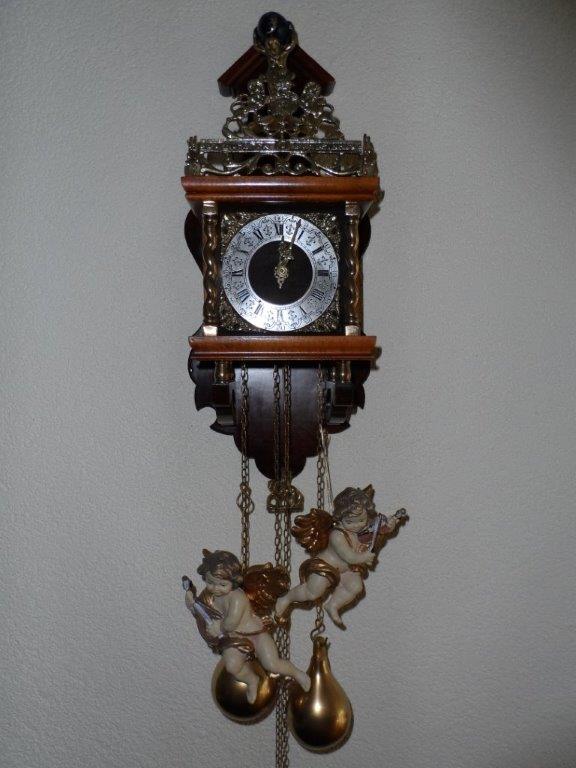
It is for sure that people who adhere to Young Earth Creationism (YEC) shall not agree with these two outcomes in Creation Time: $$ \mbox{Creation time} = \mbox{Alpha} = -A \approx 2,4 \mbox{ billion years B.C.} \\ \mbox{Creation time} = 2 \times \mbox{Hubble time} \approx -28,8 \mbox{ billion years} $$ Okay, let's assume for the moment that they are right and that the Earth and its lifeforms were created in their present forms by supernatural acts of a deity between approximately 6,000 and 10,000 years ago. Whatever. It's not too much of a difficult experiment to figure out whether the distinction between gravitational clocks and atomic clocks makes sense. An example of a "mixed" clock, which is suitable for our purpose, has been described: it's the good old pendulum.

"Common" time is measured with atomic clocks these days. So the only thing we have to do is observe a pendulum under laboratory conditions, such as a (temperature) controlled environment. If our theory is alright, then it shall be observed that the pendulum clock will be ticking faster and faster, because due to increasing mass, time intervals are decreasing (quadratically in comparison with linear). So our pendulum will be running ahead of common (atomic) time in due time. Such a simple test could even be attempted at the Logos Instituut. The rate (pendulum ticks $dT$ / atomic ticks $dt$) can be formulated quantitatively. By combining results with Narlikar's Law we have: $$ \frac{dT}{dt} = \frac{(m_0/m)^2}{m_0/m} = \frac{m_0}{m} = \left(\frac{T_0-A}{T-A}\right)^2 $$ Using alike assumptions as with the Leap Second in Creation Time, it must be noticed that the pendulum runs with shorter ticks: $$ \sqrt{\frac{dT}{dt}} = \sqrt{1-\delta} = \frac{T_0-A}{T-A} \hieruit T-T_0 = \frac{T_0-A}{\sqrt{1-\delta}}-(T_0-A) $$ Let's assume that it's possible to measure a difference of one minute between atomic time and pendulum time and that Young Earth creationism is right. Then we have: $$ T_0-A \approx 2019+6000 \SP \delta = 1/(365\times 24\times 60) \hieruit T-T_0 \approx 3 \; days $$ Therefore only three days would be needed to make a difference of one minute between laboratory pendulum time and common (atomic) time. It seems improbable that the 6000 years of YEC are compatible with our Unified Alternative Cosmology. But God only knows. I would say: let people have the guts and do the test with the pendulum :-)
But in case Young Earth Creationism is not alright, we can do things the other way around: $$ \sqrt{1-\delta} = \frac{T_0-A}{T-A} = \frac{T_0-A}{(T-T_0)+(T_0-A)} $$ Here $T=$ orbital time, $T_0=t_0=$ reference time (atomic as well as orbital) here and now, $A=$ Alpha $=$ moment of creation in orbital time, $\delta=$ relative shift $(1-dT/dt)$ between orbital time $T$ and atomic time $t$ or relative difference in elementary particle mass $(m-m_0)/m$, where $m=$ larger elementary particle mass in the future and $m_0=$ elementary particle mass here and now. The objective is to determine $A$. Let $D = T-T_0 =$ time period used for the experiment, and let's solve $A$ from the equation: $$ \left[(T-T_0)+(T_0-A)\right]\sqrt{1-\delta} = (T_0-A) \hieruit T_0-A % = \frac{T_0(1 - \sqrt{1-\delta}) - T_0 + T\sqrt{1-\delta}}{1 - \sqrt{1-\delta}} = \frac{(T-T_0)\sqrt{1-\delta}}{1 - \sqrt{1-\delta}} \hieruit - A \approx \frac{2D}{\delta} - T_0 $$ Approximately the same example as above, with years as the unit: $$ \delta = 1/(365\times 24\times 60) = \mbox{one minute} \SP D = 3 /365 = \mbox{three days} \SP T_0 = 2020 = \mbox{now} \\ \hieruit - A \approx 6,620 \; \mbox{B.C.} = \mbox{moment of creation} $$ Apart from numbers that may be nonsensical or not, the pendulum test might be considered as a crucial experiment for deciding whether UAC makes sense or not.
From an email correspondence with the author of Our Experiments and Videos the information that follows. It is argued that the purported experiment may
be not as simple as that, alas.
I think it would be very hard to get a pendulum clock to be accurate enough to see any meaningful difference
with an atomic clock - perhaps a Shortt clock might work but these are not readily available. I have compared temperature compensated
Quartz clocks, which is a form of mechanical clock,
to a Rubidium atomic clock, I think it was last year, and reached a fairly high accuracy, I was looking for
diurnal effects, and I could only find temperature effects all the way down to 1 part per billion.
Shortt clocks have been employed for detecting diurnal effects too, as revealed in
Time and tide: pendulum clocks and gravity tides.
Indeed, the gravitational acceleration $\,g\,$ cannot simply be considered as a constant. It also varies,
due to gravity tides by the moon and the sun, thus making things even more complicated.